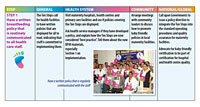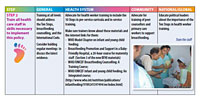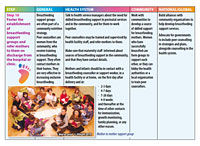|
|
|
What You Can Do: Take Action!
Every facility providing maternity services and care for newborn infants should:
Step 1: Have a written breastfeeding policy that is routinely communicated to all health care staff.
The first step is to have a written breastfeeding policy in English and the local languages. It addresses all the ten steps and states that the hospital does not accept free or subsidized supplies of infant formula and feeding bottles.
The policy is communicated to the hospital administration as well as to all the health workers in the maternity setting.
What You Can Do.
 Step 1 : WABA Action Chart Step 1 : WABA Action Chart
What You or Your Organisation Can Do >> click here
-
General
The Ten Steps call for health facilities to have written policies that are displayed for all to read, indicating that staff is committed to implementing them.
-
Health System
Visit maternity hospitals, health centres and primary care facilities and see if policies covering the Ten Steps are displayed.
Ask health service managers if they have developed a policy, and explain how the Ten Steps are now considered "best practice". Tell them about the new BFHI materials, especially Section 1 on implementation.
-
Community
Arrange meetings with community leaders to discuss how to promote baby friendly policies in local maternity facilities.
-
National / Global
Call upon Governments to issue a policy directive to integrate the Ten Steps into the standard operating procedures and quality assurance for maternity facilities.
Advocate for baby-friendly certification to be part of certification for hospital and health centre quality.
|

Step 2: Train all health care staff in skills necessary to implement this policy.
A policy is of no use unless it is implemented. So the second step is to train all doctors and nurses in skills necessary to implement this policy. It ensures that the majority of the staff members are trained in breastfeeding counselling.
What You Can Do.
 Step 2 : WABA Action Chart Step 2 : WABA Action Chart
What You or Your Organisation Can Do >> click here
-
General
Training at all levels should address the Ten Steps, breastfeeding counselling, and the International Code.
Consider holding regular meetings to discuss the latest evidence.
-
Health System
Advocate for health worker training to include the 10 Steps in pre-service curricula and in-service training.
Make sure trainers know about these materials and the internet links for them:
-
Community
Advocate for training of peer counsellors and primary care workers to support breastfeeding.
-
National / Global
Educate political leaders about the importance of the Ten Steps in health worker training.
|

Step 3: Inform all pregnant women about the benefits and management of breastfeeding.
The third step is to have sessions with pregnant women to motivate them for breastfeeding and to remove all their doubts.
What You Can Do.
 Step 3 : WABA Action Chart Step 3 : WABA Action Chart
What You or Your Organisation Can Do >> click here
-
General
By the time a baby is born, the new mother must be comfortable about breastfeeding, understand its benefits and what she has to do.
-
Health System
Advocate for breastfeeding information and discussion opportunities to be available for all women, individually and in groups as part of all antenatal care.
Talk to women about their care, and learn if they have been informed about the dvantages of breastfeeding and the risks of not breastfeeding; about how they will be helped at the time of delivery, how to hold the baby and how to ensure that the baby gets plenty of milk.
Make sure that they have relevant and accurate literature on these topics.
-
Community
Arrange Promotional activities to raise community awareness of the importance of breastfeeding and the support that new mothers need.
-
National / Global
Work to make breastfeeding an accepted norm in all sectors based on up-to-date evidence of the risks of artificial feeding;
and an understanding that women need active support from the health service and community to enable them to breastfeed effectively.
|

Step 4: Help mothers initiate breastfeeding within a half-hour of birth.
It is now well established that mothers who are supported to initiate breastfeeding soon after the baby is born are more likely to have a successful breastfeeding experience. So the fourth step is to initiate breastfeeding within a half–hour of birth.
What You Can Do.
 Step 4 : WABA Action Chart Step 4 : WABA Action Chart
What You or Your Organisation Can Do >> click here
-
General
This step now means, for all healthy newborns, skin-to-skin contact from immediately after delivery for at least one hour or until the baby has attached and fed at the breast if this takes longer.
-
Health System
Advocate for training of all birth attendants to give skilled support to mothers for skin-to-skin contact immediately after delivery, allowing the baby to attach to the breast when he or she is ready.
-
Community
Work to increase community awareness of the importance of early initiation of breastfeeding. Show the video breastfeeding crawl so people see what newborns can do.
-
National / Global
Inform health professional organisations about new research on implementation of this and other Ten Steps, and ask them to support the new practice.
 see Initiation of Breastfeeding by Breast Crawl video here see Initiation of Breastfeeding by Breast Crawl video here
|

Step 5: Show mothers how to breastfeed and how to maintain lactation, even if they should be separated from their infants.
A situation can arise when the baby has to be separated from her mother for a specific medical reason. The fifth step is to show the mother how to maintain lactation by expression of breast milk or to visit her baby in the intensive case as often as possible.
What You Can Do.
 Step 5 : WABA Action Chart Step 5 : WABA Action Chart
What You or Your Organisation Can Do >> click here
-
General
Helping mothers to breastfeed effectively with a good technique is a vital step. If infants are separated from their mothers, or are unable to suckle, their mothers need to express their milk. Health workers need skills to help mothers do these things.
-
Health System
Get to know the staff of maternity hospitals and primary care services in your area, show appreciation for their help for mothers, and make sure that they have the latest information.
Encourage them to show every mother how to position and attach her baby at the breast to prevent difficulties such as sore nipples and insufficiency of milk; and to teach all mothers to express their breast milk by hand, for comfort, to maintain their milk supply, and to ensure that babies can be fed with breast milk if they are separated. There is generally no need for a breast pump.
-
Community
Ensure that all mothers learn the techniques for breastfeeding and hand expression and how to overcome common difficulties.
-
National / Global
Advocate for skilled breastfeeding help to be available to all mothers as a routine part of Maternal and Child Health care, and for all health workers who care for mothers and babies to be trained to give effective help.
|

Step 6: Give newborn infants no food or drink other than breast milk unless medically indicated.
The sixth step stresses that a newborn baby must not be given any food or drinks other than breast milk unless it is medically indicated. As the pregnant women are counseled in advance and the hospital staff is trained, we rarely have to give anything other than colostrums – the first breast milk to the babies.
What You Can Do.
 Step 6 : WABA Action Chart Step 6 : WABA Action Chart
What You or Your Organisation Can Do >> click here
-
General
Families and health workers may believe that infants need prelacteal feeds of formula or glucose water or other drinks before their mother's milk "comes in". This may lead to failure to breastfeed. Infant formula and advertisements in maternities can mislead people on this important point.
-
Health System
Make sure that mothers receive help to breastfeed effectively, so that they do not feel a need to give a baby other drinks.
Make sure that health workers understand that supplements are seldom needed, even in the first few days when the volume of breast milk is small; and that the first milk, colostrum is what a baby needs.
Raise awareness of what are the very few medical indications for supplements and what are not medical indications, so that babies do not receive supplements unnecessarily. (see Resources section)
-
Community
Work with the community to raise awareness about the importance of colostrum, and why a baby needs nothing else in the first few days; and of continuing to breastfeed exclusively six months.
-
National / Global
Advocate for renewal of government efforts to implement, monitor and legislate all provisions of the International Code of Marketing of Breast-milk Substitutes and subsequent relevant WHA resolutions.
|

Step 7: Practice rooming-in - allow mothers and infants to remain together - 24 hours a day.
The seventh step about rooming–in is very important. Unless medically indicated, the baby remains with the mother 24 hours a day. Unless the mother is heavily sedated, she keeps the baby next to her in her bed.
What You Can Do.
 Step 7 : WABA Action Chart Step 7 : WABA Action Chart
What You or Your Organisation Can Do >> click here
-
General
In many hospitals newborns are kept in nurseries after delivery. Rooming-in allows mothers and their babies to stay together day and night to bond and to establish breastfeeding.
-
Health System
Visit maternity facilities and discuss the importance of mothers keeping their newborns with them 24 hours a day following from the initial skin-to-skin contact. The baby can be in the same bed as the mother, or in a cot beside her bed where she can see and reach him or her without getting up. The baby should not be in a cot at the end of the mother's bed.
-
Community
Support traditions and environments that allow a mother and child to be together throughout early infancy.
-
National / Global
Advocate for a policy of rooming-in for all maternity services.
Advocate for adequate paid maternity leave to enable mothers to be with their young infants and to breastfeed. Ask global organisations to support the ILO maternity leave and other breastfeeding support provisions.
|

Step 8: Encourage breastfeeding on demand.
According to the eighth step the mother is encourage to breastfeed whenever the baby wants to. This is called demand feeding. It helps in increased production and prevents undue engorgement of breasts.
What You Can Do.
 Step 8 : WABA Action Chart Step 8 : WABA Action Chart
What You or Your Organisation Can Do >> click here
-
General
Babies should feed according to their needs, not on a schedule decided by the hospital or mother. Understanding her infant's feeding cues improves breastfeeding and the mother-child relationship.
-
Health System
Encourage maternity facilities to support breastfeeding on demand, and not on a schedule. Health workers should know infant feeding cues (signs) and teach families about them.
Signs of hunger are the baby opening the mouth, rooting, sucking hands, and moving arms and legs. Crying is a distress call and a late sign.
Signs that a baby is full, are turning away, closing the mouth, and not suckling. Breastfeeding in response to feeding cues encourages appropriate intake and growth.
-
Community
Make families aware of feeding cues, and the importance of responding to them. They should feed a baby when it is hungry and not wait for it to cry; but not over feed a child and risk obesity.
-
National / Global
Advocate with government for breastfeeding on demand in all maternity facilities; and for development partners to include feeding cue recognition and responsive feeding in nutrition programmes.
|

Step 9: Give no artificial teats or pacifiers (also called dummies or soothers) to breastfeeding infants.
The ninth step rightly prohibits the use of feeding bottles and pacifiers.
What You Can Do.
 Step 9 : WABA Action Chart Step 9 : WABA Action Chart
What You or Your Organisation Can Do >> click here
-
General
During the early weeks, the baby's need to suckle should be satisfied at the breast. Using teats or pacifiers may interfere with suckling and the adjustment of the breast milk supply to the baby's requirements.
-
Health System
Ask maternity staff not to allow use of teats and pacifiers in maternities, unless medically indicated for comfort if the mother is not available. In such cases, care should be taken to avoid spill over to other infants.
Teach cup feeding for infants who cannot breastfeed.
-
Community
Talk to families and community groups about the risks of using teats and pacifiers while breastfeeding is being established.
-
National / Global
Advocate with health authorities to ensure that hospital and health centre policies do not allow teats and pacifiers to be used routinely and that communication materials include appropriate messages.
|

Step 10: Foster the establishment of breastfeeding support groups and refer mothers to them on discharge from the hospital or clinic.
After the mother is discharged from the hospital, she needs much support to breastfeed. She may have doubts if she was producing enough milk or she may have problems like engorgement or sore nipples. Hence, the tenth step recommends to either put the mother in touch with a breastfeeding support group or to help her have free access to someone in the hospital for advice as and when required.
What You Can Do.
 Step 10 : WABA Action Chart Step 10 : WABA Action Chart
What You or Your Organisation Can Do >> click here
-
General
Breastfeeding support groups are often part of a community nutrition strategy.
Peer counsellors are women from the community, who receive training in breastfeeding support. They often contact mothers in their homes. They are very effective in increasing exclusive breastfeeding.
-
Health System
Talk to health service managers about the need for skilled breastfeeding support in postnatal services and in the community, and for them to work together.
Peer counsellors may be trained and supervised by health facility staff, and refer mothers to them.
Make sure that maternity staff informed about sources of breastfeeding support in the community, and that they have contact details.
Mothers and infants should be in contact with a breastfeeding counsellor or support worker, in a health facility or at home, on the first day after delivery and at:
- 2-3 days
- 4-7 days
- 7-28 days
- 4-8 weeks
and thereafter at the time of other contacts for immunization, growth monitoring, family planning, or any other reason.
-
Community
Work with communities to develop a source of skilled support for breastfeeding mothers. Women who have successfully breastfed can form groups to support each other, or they can lobby the health authorities or a local organisation to train peer counsellors.
-
National / Global
Build alliances with community organisations to help develop breastfeeding support services.
Advocate for governments to include peer counselling in strategies and plans, alongside counselling in the health system.
|

15 August, 2013
|
